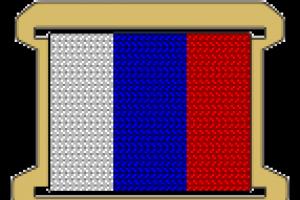In autumn, nature is full of bright colors, which makes anyone incredibly happy. Every autumn there are several bright days, when the sun is still warm, the leaves are glowing with red-orange colors, and the mountain ash is waving its red tassels. Today we will talk about how to make a rowan branch quickly and easily with your own hands.
We sculpt a rowan branch with our own hands from plasticine in MK
Plasticine is an excellent material for modeling enthusiasts. Children especially love to sculpt something from plasticine. Making a rowan brush from plasticine with your own hands is very simple; for this we need very little material:
- Plasticine black, black, orange, green, brown;
- Scalpel or plasticine knife;
- Modeling board;
Instead of a board, the basis can be a sheet of colored cardboard. You need to take a piece of brown plasticine and roll it into a rod of arbitrary length, up to half a centimeter thick, this will be the basis for the twig. We cut the workpiece into any number of branches and branches, you can make 2-4 pieces, on one side we make an end converging into a thin line. Then we mold the blanks in the shape of a twig onto the base.
Let's start sculpting rowan berries. We tear the orange plasticine into small pieces and roll into pea-sized balls, about 10 pieces. You need to glue a small black or brown dot to each berry. To make the berries look like real ones, you need to make small cuts or scratches at each point.
We sculpt the leaves from green and yellow plasticine, you can also add a few orange ones. The leaves should not be too large; after you cut out several leaves from a block of plasticine, you should give them a design; this can be done perfectly with a toothpick
The finished composition should be similar to the one shown in the photo.

Crochet rowan with diagrams and job description

The leaf is knitted according to this pattern.
- Cast on 10 air loops (VP) in the chain.
- Next we knit in the back loop, insert the hook into the second loop and pull it out.
- Yarn over.
- Insert the hook into the next back half loop and pull out the loop. There will be two loops on the hook.
- Yarn over to the end of the chain and pull out a loop in the next back half loop. There should be a total of 18 loops on the hook.
- We close the loops. We make a yarn over. Pull the yarn through the first three loops in one go.
- After yarn over, pull the thread through the next three loops again. Repeat until there are 4 loops left on the hook.
- Yarn over three loops; there will now be 2 loops on the hook.
- Yarn over and pull the thread through the remaining 2 loops, the row is closed, and 1 loop remains on the hook.
- After this, the second side is knitted, the knitting is turned to the other side and knitted on the opposite side with a chain of air loops, each time inserting the hook into the remaining half-loop
- Insert the hook into the second loop from it, pull it out and yarn over.
- Pull out the next loop, leaving four loops on the hook.
- Repeat until the end of the chain.
- Closing the loops. Yarn over Pull the thread through three loops at a time. Repeat yarn over and pull through. Until there are four loops left.
- Yarn over Pull through three loops, two remain.
- Yarn over, pull through two.
The second side of the leaf is also ready.
There is also a scheme for berries:
- Cast on a chain of 4 chain stitches, then close into a SS circle.
- 8 single crochets in a ring. Do not close the circular row SS.
- Continue sc over completed row.
- Insert the hook into the ring each time.
- In total, perform 44 single crochets in the round.
- Single crochets will be placed on top of each other, tie tightly and form a berry.
- Break the thread and unroll the work. The wrong side of the knitting is the front side for the berry.
By making several berries and leaves in this way, you can form a crocheted composition.
Let's look at another simple option - a sprig of rowan from beads
For lovers of bead weaving, there is also an option for a rowan branch.
For this we need small green beads, cutting, red-pink beads, brown beads, cutting. We will weave on a base of copper wire.
The first step is to make a rowan tassel. To do this, we collect branches of any length brown, and at the tip a red-pink bead is secured with a brown bead. You need to make about 12 of these berries. Several rowan trees can be attached to one branch.
- 1 piece;
2-4. 2 pieces each;
5-7. 3 pieces each;
8-10. 4 pieces each;
11-13. 5 pieces each;
14-16. 4 pieces each;
17-19. 3 pieces each;
20-22. 2 pieces;
- 1 piece.
Each branch has 13 leaves. The general view of the composition is shown in the photo.

We learned how to make a rowan sprig using three different needlework techniques. As you can see, this is not difficult to do. This craft will be a rather colorful decoration for your room. We also invite you to watch a short video collection on how to make a sprig of rowan quickly and easily with your own hands
Video selection on the topic of the article
Preparations for the winter
What can you cook from rowan berries?

Red rowan is a largely underrated berry. We admire its autumn beauty, but at the same time we know quite little about the healing properties of this berry, about the methods of its preparation and about culinary recipes using it. Mid-autumn is the right time to collect rowan; it is usually recommended to do this after the first frost.
1:1102 1:1107In count vitamin C rowan is only slightly inferior to lemon, and carotene it contains even more than carrots. In addition, rowan is a source vitamins PP, group B, it is able to cope with bacteria harmful to the body such as salmonella and staphylococcus. Rowan berries due to the content they contain sorbitol can lower cholesterol levels, and their constituent pectin improves intestinal function, suppresses increased gas formation.
1:19451:4
Rowan is a strong antiseptic. Its fruits contain a huge amount sorbic acid, which indicates the unique properties of protecting canned and fresh foods from spoilage, since this substance with helps inhibit the growth of microorganisms. For example, fresh fish will not spoil for a long time if you wrap it in rowan leaves.
1:618 1:623Rowan berries rich in pectins, which are very beneficial for the intestines and gastrointestinal tract in general. Pectins contribute suppression of carbohydrate fermentation, reduction of gas formation. It is thanks to pectins that rowanberry jam is so tasty and healthy! The essential oil contained in rowan berries has a unique aroma.
1:1209 1:1214So draw your conclusions - is it worth using the healing and health-improving fruits of rowan in your diet?! Of course!
1:1436 1:1441
2:6
Rowan grows everywhere. Near my house, near work, on the highway on the way to the dacha. I used to think it was an ornamental tree. But it turns out that you can make healthy juice, delicious jam, aromatic wine, healing syrup from rowan berries, and even use them in canning!
2:502 2:509Cut off the rowan clusters along with the berries. Rowan fruits retain their healing properties throughout the winter. You can dry the rowan by first removing the stems. Dry the berries in the oven, spreading them in a thin layer on a baking sheet.
2:924 2:929The fruits must be collected after the first frost, the bark is better during the period of sap flow, but it is also possible in winter. You can collect rowan before frost by placing it in the freezer for 12 hours. In this case, the bitterness will disappear, and rowan can be used to prepare delicacies and healing decoctions.
2:1461 2:1466
3:4
Rowan jam.
3:50To prevent rowan from becoming bitter, first freeze it in the freezer, then boil the syrup (for 1 liter of water + 300 g of sugar + 4 g of citric acid), dip the thawed berries in the hot syrup and leave until the next day. The next day, bring to a boil and cook over low heat for about 10 minutes. Pour the hot jam into clean jars and cover with metal lids.
The jam has an interesting taste and a very beautiful color.

Pie with rowan filling:
4:1399We will need:
4:1436200g. flour
200g. oils
100g. Sahara
100g. grated almonds
1 egg
0.5 tsp cinnamon
1 tsp grated lemon zest
1 tbsp. lemon juice
Preparation:
4:38Prepare the dough from the ingredients, knead, roll into a ball and refrigerate for an hour. Then roll out 2/3 of the dough into a layer, spread the filling and cover with a layer made from the remaining dough.
Filling: pour boiling water over the berries and leave for 5-10 minutes. Prepare syrup: 1 kg. sugar and 1 kg. berries for 500g. water. Drain the cooled boiling water and pour syrup over the berries overnight. Then bring the mixture to a boil, reduce it a little and cool.

Rowan fig
rowan - 1 kg
sugar - 1.2 kg
water - 2-3 glasses
salt.
Peel, wash and place rowan berries collected after the first frost in a saucepan, which is tightly closed with a lid. Place the pan in the oven at 50°C for 4-5 hours. When the rowan becomes soft, transfer it to a basin, add hot water so that it just covers the berries, and cook. After cooking, rub the berries through a fine sieve. Add an equal amount of sugar to the resulting puree and, stirring so as not to burn, cook it over low heat until the mass thickens and easily separates from the bottom of the basin. Place the thick mass in an even layer in a porcelain dish moistened with cold water and place in a warm place for 2-3 days. Then cut the dried mass into even squares and sprinkle with sugar or powdered sugar (200 g per 1 kg of puree), put in glass jars, cover with parchment paper and tie. Store figs in a dry place at a temperature of 7-10°C.
5:30675:4

“Suzdal tincture” is a semi-sweet, low-proof tincture.
6:647Prepared with alcoholized apple juice and fruit drinks: cranberry, rowan and chokeberry fruit juice. It has a reddish-orange color, sweet and sour taste, complex aroma with a hint of rowan. Alcohol content 25%.
6:1060 6:1065
7:4
Candied rowan fruits
7:52Whole berries are boiled in sugar syrup until completely cooked. Then they are placed in a colander to allow the syrup to separate. (The syrup can be used for other purposes, such as on pancakes or as a gravy for pudding). The berries are laid out in one layer on a sieve and dried in the sun, in the oven or oven at a temperature of 30-40°C, after being sprinkled with powdered sugar or granulated sugar. The prepared candied fruits are placed in glass jars, sealed tightly and placed in a dry place.
7:940 7:945
Rowan jam
Select well-ripened fruits and wash in cold water. To reduce bitterness, immerse for 3-5 minutes in a boiling 2.5-3% solution of table salt. After blanching, rinse the fruits thoroughly in cold water. Pour the prepared fruits with hot sugar syrup (750 g of sugar per 1 kg of fruit) and leave for 3-4 hours to stand. Separate the syrup from the fruit, heat to a boil and boil for 5-6 minutes. Pour hot boiled syrup over the fruits and leave for 4-5 hours. Add sugar (750 g per 1 kg of fruit) during the second and third cooking (a 4-5 hour break between them). The final boiling of the fruits together with the syrup is carried out during the fourth cooking.
8:26248:4

Rowan jam with apples or pears
9:602Blanch the rowan fruits in a boiling 2.5-3% solution of table salt. To the prepared rowan fruits (1 kg), add sliced and blanched apples (250-400 g), sugar (per 1 kg of mixture 1.2-1.3 kg of sugar). Cook like rowan jam.
9:1038Prepare rowan and pear jam in the same way.
9:1130 9:1135
Rowanberry syrup
Pour washed fruits (2 kg) with water and cook until softened, rub through a sieve and squeeze out the juice. Pour 35% sugar syrup (450 ml) into the juice (550 ml), bring to a boil and pour into bottles for storage.
10:388 10:393
Rowan jelly
11:949Add 1 glass of water and granulated sugar (to taste) to the rowan syrup (2 tablespoons), bring to a boil and gradually pour in the starch dissolved in 1 glass of water (1 tablespoon). Stir and bring to a boil.
11:1335 11:1340
12:4
Rowan jelly
12:44Blanch fruits touched by frost (1 kg) in a hot solution of table salt, then rinse and boil in water (2 cups). Squeeze out the boiled mixture through cheesecloth or cloth. Add granulated sugar (100 g) to the juice and cook for a short time. Let it harden in the refrigerator.
12:559 12:564
“Rowanberry in Sugar”
13:1125Blanch the sorted and washed fruits (1 kg) in a hot solution of table salt. Thoroughly grind granulated sugar (150 g) with the whites of 2 fresh eggs until a homogeneous white mass is formed, add the juice of a small lemon and stir until thickened. Roll the air-dried fruits first in the resulting mass, and then in powdered sugar (50 g) and place them in one row on a tray to dry.
13:185113:4

Rowan on honey
14:555Bake fruits (1 kg), collected after the first frost, in the oven or oven on a baking sheet. Bring honey (250 g) to a boil, mix with baked rowan fruits and cook like jam.
14:868 14:873
Rowan puree
15:1425Blanched and washed fruits in a hot solution of table salt through a meat grinder, mix with granulated sugar in a 1:1 ratio, put into jars and pasteurize at a temperature of 95°C: 0.35 l capacity - 15 minutes, 0.5 l - 20 minutes . If the ratio of crushed fruits and sugar is 1:2, the puree does not need to be pasteurized, but then it should be stored in the refrigerator.
15:207115:4

Rowan jam
16:562Blanched and washed fruits (1 kg) in a hot solution of table salt in water (1 glass) until softened, then rub through a sieve, add granulated sugar (500 g) and cook until the desired thickness.
16:930 16:935
Rowan jam with apples and carrots
17:1532Separate the frozen fruits from the stalks, sort and rinse. To reduce bitterness, immerse for 2-3 minutes in a boiling 2-3% solution of table salt (20-30 g per 1 liter of water), remove from the solution and rinse with cold water. Wash the apples, remove peels and seeds and cut into pieces. Peel the carrots, rinse, cut into pieces and blanch in boiling water until softened. Combine prepared rowan fruits (600 g), apples (300 g) and carrots (100 g), add water or apple juice (300 ml) and cook over moderate heat until soft. Quickly rub the resulting mass through a colander, put on fire, cook for 8-10 minutes, add sugar (600 g) and cook with continuous stirring until tender (until it thickens).
17:1315 17:1320 18:182818:4
Rowanberry marshmallow
18:51Place blanched and washed fruits (1 kg) in a hot solution of table salt into an enamel pan, add 1 glass of water, bring to a boil and cook until softened, then rub through a sieve, add granulated sugar (600 g) and cook, stirring until the mass does not acquire the consistency of thick sour cream, then place it in a 1.5 cm thick layer in wooden trays and dry in the oven at low temperature.
18:820 18:825
Rowan jelly
19:1384Pour boiling water over the fruits (1 kg) for 15 minutes, drain in a colander. When the water has drained, knead with a wooden pestle, pour boiling water (150 ml), rub through a sieve. Transfer the mixture into a bowl, add sugar (1 kg) and cook over low heat until marmalade thickens, cool. Then place on parchment paper, sprinkle with powdered sugar or sugar, smooth with a knife, and dry on a baking sheet in a low-heat oven. Cut the marmalade into pieces of different shapes and put them in jars.
19:220019:4

Rowan fizzybrew
20:562Mash the fruits (350 g) blanched in a hot solution of table salt and washed with a pestle, place in a saucepan, add water (4 l) and cook until softened. Then remove from heat, add granulated sugar (150 g), dissolve it and place the pan in a warm place for fermentation, covering it with gauze. When fermentation begins, strain the drink, pour into bottles, adding 3-4 raisins to each, and seal well. Store bottles in a cool place in a horizontal position.
20:1424 20:1429
21:4
Rowan kvass
21:45Mash the fruits (1 kg), blanched in a hot solution of table salt and washed with a wooden pestle, add water (4 l) and cook for 10 minutes. Strain the juice, adding granulated sugar (2 cups) and cool. Then pour in the diluted yeast (10 g), mix well, pour into bottles, seal and put in a cool place for 3 days.
21:649 21:654
Rowan liqueur
22:1211Mash the fruits (2 kg), fill them with water (1 l), add granulated sugar (500 g). After 4-5 days, squeeze out the juice, pour it into bottles, close them with corks and leave them in a cool place for 30-40 days in a horizontal position.
22:1589 22:4
Cucumbers with bunches of rowan
23:576Cucumbers - 2 kg, chokeberries (in clusters) - 500g, sugar - 70g, salt - 30g, apple cider vinegar - 50g, water - 1 l. The cucumbers are washed, the ends are cut off and placed vertically in prepared 0.5 liter or 0.75 liter jars. Scalded bunches of rowan are placed between the cucumbers. Salt, sugar, vinegar are diluted in water, brought to a boil and poured over the cucumbers. Filling is carried out three times, after which the jars are rolled up and placed upside down until cooled.
23:1348 23:1353Evgenia Smirnova
To send light into the depths of the human heart - this is the purpose of the artist
Content
Have you ever wanted to create a fake with your own hands? Making a small tree, such as rowan, using beadwork is a fun process. Weaving trees with beads is not limited to strict instructions; you can always get creative and add something of your own.
Features of beading
If this is your first experience creating a small craft with your own hands, then it is better to refer to the video instructions. It is better to choose larger beads for work, because you do not yet have the dexterity that is required for filigree small work. The material comes in various colors, which will allow you to realize your fantasies; in addition, budget collections of beads are available for beginners, which is also important. Schemes of a variety of ideas can be found on Internet sites, or, when you have more experience and your hand is full, come up with it yourself.
How to make a rowan from beads with your own hands
Beaded rowan is a simple decoration that makes an excellent gift. To create you will need the following items:
- beads of different sizes;
- dense thread;
- wire;
- decorative stand.
Let's get started:
- For each leaf you need to build nine small parts. You should start by creating small parts. Each leaf will be built on five rows. Only one green bead is used for the first and last rows, and two for the central ones.
- The nine resulting parts must be combined into a sheet. To do this, you need to twist three small parts at the very base, and then attach other elements to them in pairs.
- We repeat the above 14 times. The beaded leaves are ready.
- It's time for the grapes. You need to take the wire, measure the length - 65 cm, then step back ten cm from the edge, attach the first bead. To secure it, you then need to twist the ends.
- After two centimeters we string the next bead, then re-twist it. In this way you need to put on ten beads.
- All berry beads should be twisted.
- Repeat steps 4-6 to get three identical bunches.
- Then assemble a brush from them. To do this, place them one on top of the other, then twist them at the junction.
- Complete seven red clusters.
- The completed parts must be wrapped with thread to form the branches of our tree.
- The clusters and leaves should be connected carefully, twisting their bases.
- After making a small indent, you need to attach another bunch of leaves.
- We collect seven such branches. At the base of each part you need to add a winding with a beautiful thread.
- Take part of the wire, which will be the trunk, and gradually attach branches to it.
- Each attachment point should be closed with threads.
- Make a stand: for this you can use plasticine or plaster, then “plant” the finished tree there.

Beaded berries
Do-it-yourself bead trees are assembled gradually. Any craft made from small beads is reminiscent of origami: you need to repeat the same steps. First you need to string the beads onto the wire, then twist it. Having put on ten beads in this way, they should then be connected to each other, creating peculiar bunches. They are already gathering in clusters. You need to weave 10-11 such bunches.
Leaves
The next step is to create leaves using green beads. The parallel weaving technique is used. One bead is strung on the first row, then two, and one again on the last row. There should be seven rows in total. Then these details are combined into a single piece of paper, familiar from childhood. First, three elements are combined, everything is twisted at the base, and then the remaining ones are attached in pairs.

Rowan branch
The penultimate stage is the creation of tree branches. You need to take the finished leaf, along with one bunch. Place them on top of each other and rewind the base. Then put the next leaf and attach it again, and after that take a bunch. The final step is to repeat everything again, ending with a piece of paper. You should get a neat branch. In order to hide the wire, you can use brown threads.
Wood assembly
The finishing line is the formation of the trunk. Thick wire will become the basis of the future tree. You need to wrap branches around it from top to bottom. You shouldn’t stop at the standard arrangement of branches and berries; you can experiment and try to bend the branches in different directions and evaluate how it looks. Having found the ideal angle, secure this position with threads. The beaded rowan is ready!
Get even more DIY ideas.

Video tutorials on weaving rowan from beads
Complex instructions are not suitable for beginners in this kind of weaving, so it is better to refer to video tutorials on making cute crafts. Masters of their craft will tell you how the work should be done, what size of wire to measure, and how many beads to take. What techniques can be used to convey the effect of a winter or autumn tree and how to create its chokeberry variety?
Salt dough gives you the opportunity to make with your hands something that sometimes you cannot keep alive. A sprig of rowan will lift your spirits at any time of the year with its beauty and brightness. This is what we will be sculpting today. To get started, let's prepare:
- salt dough of two colors: red and green.
- birch branches;
- old disk;
- We will also need gouache when designing the finished work.
Arrange the branches on the disk the way we need them. It is better to remove the excess length of branches.

Make oblong shaped leaves from green dough. Using a stack or a toothpick, draw a design inside the leaf. We begin to lay out the leaves on the branch. We fasten the parts together in a simple way - wet and attach.

We form a bunch of rowan berries from the balls of red dough. On the berries we mark the center pattern with a cross.

On the remaining branches we make leaves of the same size.

Dry the finished rowan branch in the usual way, but if you are in a hurry, then place the branch in the oven, heating to 80 degrees, for 5-6 hours. Then paint with gouache in appropriate tones to add brightness to the work. When the paint is dry, coat with acrylic varnish for shine.

Glue the bunch onto the base with universal glue. This is such an autumn picture you got! Isn't it beautiful? Based on materials from the site http://www.millionpodarkov.ru/
In autumn, nature is full of bright colors, which makes anyone incredibly happy. Every autumn there are several bright days, when the sun is still warm, the leaves are glowing with red-orange colors, and the mountain ash is waving its red tassels. Today we will talk about how to make a rowan branch quickly and easily with your own hands.
We sculpt a rowan branch with our own hands from plasticine in MK
Plasticine is an excellent material for modeling enthusiasts. Children especially love to sculpt something from plasticine. Making a rowan brush from plasticine with your own hands is very simple; for this we need very little material:
- Plasticine black, black, orange, green, brown;
- Scalpel or plasticine knife;
- Modeling board;
Instead of a board, the basis can be a sheet of colored cardboard. You need to take a piece of brown plasticine and roll it into a rod of arbitrary length, up to half a centimeter thick, this will be the basis for the twig. We cut the workpiece into any number of branches and branches, you can make 2-4 pieces, on one side we make an end converging into a thin line. Then we mold the blanks in the shape of a twig onto the base.
Let's start sculpting rowan berries. We tear the orange plasticine into small pieces and roll into pea-sized balls, about 10 pieces. You need to glue a small black or brown dot to each berry. To make the berries look like real ones, you need to make small cuts or scratches at each point.
We sculpt the leaves from green and yellow plasticine, you can also add a few orange ones. The leaves should not be too large; after you cut out several leaves from a block of plasticine, you should give them a design; this can be done perfectly with a toothpick
The finished composition should be similar to the one shown in the photo.

Crochet rowan with diagrams and job description

The leaf is knitted according to this pattern.
- Cast on 10 air loops (VP) in the chain.
- Next we knit in the back loop, insert the hook into the second loop and pull it out.
- Yarn over.
- Insert the hook into the next back half loop and pull out the loop. There will be two loops on the hook.
- Yarn over to the end of the chain and pull out a loop in the next back half loop. There should be a total of 18 loops on the hook.
- We close the loops. We make a yarn over. Pull the yarn through the first three loops in one go.
- After yarn over, pull the thread through the next three loops again. Repeat until there are 4 loops left on the hook.
- Yarn over three loops; there will now be 2 loops on the hook.
- Yarn over and pull the thread through the remaining 2 loops, the row is closed, and 1 loop remains on the hook.
- After this, the second side is knitted, the knitting is turned to the other side and knitted on the opposite side with a chain of air loops, each time inserting the hook into the remaining half-loop
- Insert the hook into the second loop from it, pull it out and yarn over.
- Pull out the next loop, leaving four loops on the hook.
- Repeat until the end of the chain.
- Closing the loops. Yarn over Pull the thread through three loops at a time. Repeat yarn over and pull through. Until there are four loops left.
- Yarn over Pull through three loops, two remain.
- Yarn over, pull through two.
The second side of the leaf is also ready.
There is also a scheme for berries:
- Cast on a chain of 4 chain stitches, then close into a SS circle.
- 8 single crochets in a ring. Do not close the circular row SS.
- Continue sc over completed row.
- Insert the hook into the ring each time.
- In total, perform 44 single crochets in the round.
- Single crochets will be placed on top of each other, tie tightly and form a berry.
- Break the thread and unroll the work. The wrong side of the knitting is the front side for the berry.
By making several berries and leaves in this way, you can form a crocheted composition.
Let's look at another simple option - a sprig of rowan from beads
For lovers of bead weaving, there is also an option for a rowan branch.
For this we need small green beads, cutting, red-pink beads, brown beads, cutting. We will weave on a base of copper wire.
The first step is to make a rowan tassel. To do this, we collect branches of any length brown, and at the tip a red-pink bead is secured with a brown bead. You need to make about 12 of these berries. Several rowan trees can be attached to one branch.
- 1 piece;
2-4. 2 pieces each;
5-7. 3 pieces each;
8-10. 4 pieces each;
11-13. 5 pieces each;
14-16. 4 pieces each;
17-19. 3 pieces each;
20-22. 2 pieces;
- 1 piece.
Each branch has 13 leaves. The general view of the composition is shown in the photo.

We learned how to make a rowan sprig using three different needlework techniques. As you can see, this is not difficult to do. This craft will be a rather colorful decoration for your room. We also invite you to watch a short video collection on how to make a sprig of rowan quickly and easily with your own hands
Video selection on the topic of the article








